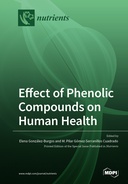Explore

Effect of Phenolic Compounds on Human Health
0 Ungluers have
Faved this Work
Login to Fave
Phenolic compounds are non-essential dietary compounds that are found in many vegetables (i.e. onion, cabbage, broccoli and parsley), fruits (i.e. cherries, grapes, berries and pears), cereals and beverages (i.e. red wine, tea and chocolate). These heterogeneous compounds are produced as secondary metabolites. Structurally, these compounds are characterized by comprising an aromatic ring with one or more hydroxyl groups that can be classified into two groups: flavonoids and non-flavonoids. Phenolic compounds have received considerable attention for its health-promoting properties in many chronic disorders including diabetes, cardiovascular diseases, cancer and neurodegenerative diseases, among others. These health benefits are mainly attributed to its antioxidant properties. Phenolic compounds act as antioxidant by scavenging free radicals, metal chelation and endogenous antioxidant system upregulation (enzymatic antioxidants such as catalase, superoxide dismutase and glutathione peroxidase and non-enzymatic antioxidants such as glutathione).The consumption of exogenous medicinal plants and food rich in phenolic compounds represent a promising therapeutically to prevent many chronic diseases and improve health.This Special Issue entitled “Effect of Phenolic Compounds on Human Health” include research articles and review articles on phenolic compounds and its role in health (i.e. flavonoids and diabetes, polyphenols and liver diseases, polyphenols and obesity, polyphenols and cardiovascular diseases and polyphenols and neuroprotection).
This book is included in DOAB.
Why read this book? Have your say.
You must be logged in to comment.
Rights Information
Are you the author or publisher of this work? If so, you can claim it as yours by registering as an Unglue.it rights holder.Downloads
This work has been downloaded 158 times via unglue.it ebook links.
- 158 - pdf (CC BY) at Unglue.it.
Keywords
- 3T3-L1 adipocytes
- 8-iso prostaglandin F2a
- Adipogenesis
- adipokines
- adiposity
- ageing
- Akt signaling pathways
- ALD
- ALF
- Anthocyanins
- anti-inflammatory
- anti-inflammatory cytokines
- anti-obesity
- antioxidant
- antioxidant potential
- beer
- Biology, Life Sciences
- bitter
- BMI
- Body Composition
- Citrus
- Cultural Studies
- curcuminoids
- diabetes
- dietary antioxidants
- Dili
- endothelial dysfunction
- epicatechin
- ERK 1/2 signaling pathways
- exercise intensity
- Flavonoids
- Food & society
- food intake
- glucagon/insulin
- glyoxalase
- HCC
- health-related quality of life
- hop
- Hypertrophy
- Immunomodulation
- Inflammation
- Insulin Resistance
- Inula britannica
- lignans
- lingonberry
- lipogenesis
- Liver
- low-grade inflammation
- Mathematics & science
- Mediterranean Diet
- methylglyoxal
- mitotic clonal expansion
- Moringa oleifera
- n/a
- NAFLD
- Neurodegenerative disorders
- Neuroprotection
- Nutrients
- Obesity
- Oxidative Stress
- phenol
- phenolic acids
- phenolic compounds
- polyphenol
- Polyphenols
- post-exercise recovery
- prenylflavonoids
- pro-inflammatory cytokines
- procyanidins
- Reference, information & interdisciplinary subjects
- Research & information: general
- Society & culture: general
- Society & Social Sciences
- stilbenes
- taste genetics
- taste receptors
- total antioxidant capacity
- tumor
- ultra-endurance
- Vitality
- Xanthohumol
Links
DOI: 10.3390/books978-3-0365-2899-1Editions

